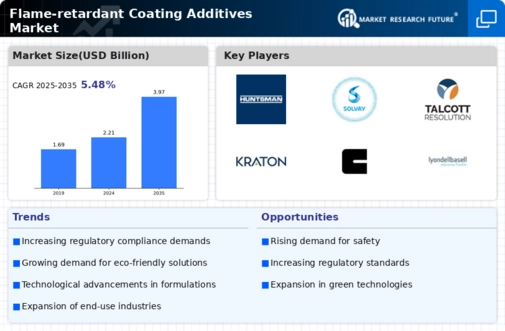Growing Awareness of Fire Hazards
There is a notable increase in awareness regarding fire hazards and the importance of fire safety measures, which is positively impacting the Global Flame-retardant Coating Additives Market Industry. Educational campaigns and media coverage about fire incidents have heightened public consciousness about the risks associated with flammable materials. This awareness drives demand for flame-retardant coatings across various applications, including residential, commercial, and industrial sectors. As consumers and businesses prioritize safety, manufacturers are responding by developing more effective flame-retardant solutions. This shift in mindset is likely to sustain market growth, as stakeholders increasingly recognize the value of investing in fire safety.
Increasing Fire Safety Regulations
The Global Flame-retardant Coating Additives Market Industry is experiencing growth due to the stringent fire safety regulations imposed by governments worldwide. These regulations mandate the use of flame-retardant materials in various sectors, including construction, automotive, and aerospace. For instance, the National Fire Protection Association in the United States has established codes that require flame-retardant coatings in specific applications. This regulatory environment drives manufacturers to adopt flame-retardant additives to comply with safety standards, thereby expanding the market. As a result, the market is projected to reach 2.21 USD Billion in 2024, reflecting the increasing emphasis on safety and compliance across industries.
Emerging Markets and Economic Growth
Emerging markets are playing a pivotal role in the expansion of the Global Flame-retardant Coating Additives Market Industry. As economies grow, there is a corresponding increase in construction activities and industrialization, leading to higher demand for flame-retardant solutions. Countries in Asia-Pacific and Latin America are witnessing rapid urbanization, which necessitates the implementation of fire safety measures in new developments. This trend is further fueled by government initiatives aimed at enhancing safety standards in these regions. The market's growth trajectory is expected to be robust, driven by the economic development and increasing safety awareness in emerging economies.
Market Trends and Growth Projections
The Global Flame-retardant Coating Additives Market Industry is characterized by several trends that indicate its growth potential. The market is projected to reach 2.21 USD Billion in 2024 and is expected to grow to 3.97 USD Billion by 2035, reflecting a strong upward trajectory. The anticipated CAGR of 5.46% from 2025 to 2035 suggests a sustained demand for flame-retardant additives driven by regulatory compliance, technological advancements, and increasing safety awareness. These trends highlight the importance of innovation and adaptation in the industry, as manufacturers strive to meet the evolving needs of various sectors while ensuring compliance with safety standards.
Rising Demand from Construction Sector
The construction sector is a major driver of the Global Flame-retardant Coating Additives Market Industry, as the demand for fire-resistant materials continues to rise. With urbanization and infrastructure development on the rise globally, the need for safe building materials becomes paramount. Flame-retardant coatings are increasingly applied to structural elements, facades, and interiors to enhance fire safety. This trend is particularly evident in regions experiencing rapid urban growth, where safety standards are becoming more stringent. The market's expansion is further supported by projections indicating that it will reach 3.97 USD Billion by 2035, reflecting the construction industry's commitment to safety and compliance.
Technological Advancements in Coating Solutions
Innovations in coating technologies are significantly influencing the Global Flame-retardant Coating Additives Market Industry. Advances in formulations and application techniques enhance the performance of flame-retardant coatings, making them more effective and versatile. For example, the development of nanotechnology-based additives has improved the thermal stability and fire resistance of coatings. These advancements not only meet regulatory requirements but also cater to the evolving needs of end-users seeking high-performance solutions. Consequently, the market is expected to grow at a CAGR of 5.46% from 2025 to 2035, indicating a robust demand for innovative flame-retardant solutions.






















